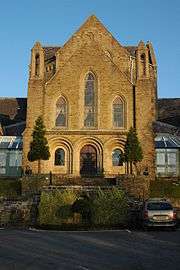Shrigley Hall
Shrigley Hall is a former country house standing to the northwest of the village of Pott Shrigley, Cheshire, England. It has since been used as a school, when a chapel was added, and later as a hotel and country club operated by The Hotel Collection.

History
The hall was built in about 1825 for William Turner, a Blackburn mill owner and Member of Parliament. The architect was Thomas Emmet senior from Preston.[1][2] During the 20th century the building was used as a school by the religious institute of the Salesians of Don Bosco,[1] who in 1936 added a chapel to the south of the house, dedicating it to Saint John Bosco. This was designed by the Arts and Crafts architect Philip Tilden.[1] An attic was added to the house in the middle of the 20th century.[2] In 1989 the house and church were converted into a hotel and country club.[3]
Architecture

House
This is designed in Regency style,[1] and constructed in ashlar brown sandstone with slate roofs.[2] The house has two storeys and an attic, with a symmetrical entrance front of eleven bays. The central three bays and the bays at each end project forward slightly. At the centre, five steps lead up to a portico with four Ionic columns supporting a pediment with a plain frieze. In the pediment is a medallion containing a lion and a cross. The windows are sashes, those in the end bays having three lights; elsewhere they have single lights. The doorway has a curved architrave, over which is a rectangular fanlight. To the rear of the house are two wings in rubble stone, the one on the left having three storeys, and the one on the right two storeys.[2] Originally the entrance hall was open internally to a dome and a skylight, and it contained an Imperial staircase. The staircase has been removed and a floor inserted. The interior contains "good Neoclassical plasterwork".[1] The house is recorded in the National Heritage List for England as a designated Grade II* listed building.[2]
Chapel
This is constructed in sandstone rubble with a slate roof. Its plan consists of an octagonal nave with a transept at each cardinal point, and a chancel. Radiating outwards between the transepts are small chapels. The ground floor includes Romanesque features including round-headed arches, and above them there are lancet windows. Over the nave is a domical vault. The chapel contains paired round-headed sedilia on each side.[4] The architect painted the Stations of the Cross and the altarpiece, but with the conversion of the building into a hotel, the fittings have been removed.[1] The chapel is designated as a Grade II listed building.[4]
References
- de Figueiredo, Peter; Treuherz, Julian (1988), Cheshire Country Houses, Chichester: Phillimore, p. 270, ISBN 0-85033-655-4
- Historic England, "Salesian Missionary College (1232168)", National Heritage List for England, retrieved 12 August 2012
- The Shrigley Hall Hotel, Golf & Country Club, The Puma Hotels Collection, retrieved 8 July 2011
- Historic England, "College of Missionary Chapel (1232118)", National Heritage List for England, retrieved 12 August 2012
Further reading
- Hartwell, Clare; Hyde, Matthew; Hubbard, Edward; Pevsner, Nikolaus (2011) [1971], Cheshire, The Buildings of England, New Haven and London: Yale University Press, p. 543, ISBN 978-0-300-17043-6